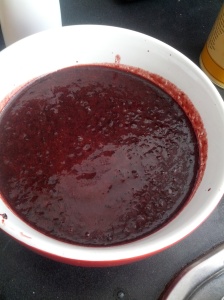This is a beer I made with a view to entering it in a homebrew competition run by a local bar. I ended up pulling out at the last minute because I didn’t like what I’d been hearing about the way it was run.

This is what 1.5kg of pureed cherries looks like. Because you’ve always asked yourself that, haven’t you?
I was told they’d have brewery reps and professional brewers judging, but they ended up having the bar staff give 50 per cent of the score and the other half would come from the punters on the night. Which meant I likely knew more about beer than the people judging – which just seemed wrong.
The straw that broke the camel’s back was hearing from a guy who had missed the last pale ale heat. The organisers told him he could just enter his beer in the final anyway. I heard that and thought, ‘‘nah, that’s me done’’. I put a lot of time and effort into brewing beer, and it just felt like this contest wasn’t respecting that at all. So I pulled the pin – which meant I could keep all the tasty Cherry Ripe stout to myself.
And it has worked out very well. So well that I reckon it could well have won the comp – if I so say so myself. While it does resemble a Cherry Ripe chocolate bar it’s not a really sweet beer – at least not to my palate anyway. So maybe give this a beer a try sooner rather than later, because the stout weather is coming to an end.
Ingredients
Two cans of Coopers liquid malt extract
500g lactose
400g chocolate malt
300g crystal malt
200g black malt
180g cocoa powder
400g shredded coconut – toasted
1.5kg pureed frozen cherries
(plus an extra 900g of cherries if you screw things up like I did)
30g Willamette hops
Yeast: Safale S-04
Steps
1) Mash the grains at 77 degrees Celsius for 40 minutes
|
2) Add lactose to the wort while sparging
3) Top up to eight litres and throw in the hops at the start of the boil
4) While the boil is going lightly toast the coconut in the oven by using the grill option. Keep an eye on it, because it can burn quickly.
5) With 20 minutes to go in the boil throw the coconut in the pot.
6) At flameout, in goes the cocoa powder and pureed cherries (note the first observation below)
7) Once the wort is chilled enough to move into the fermenter, pour it through a strainer to remove the cherries and coconut.
Observations
• My wort cooled down quicker than expected and so the cherries didn’t get much contact time with the wort. That led to the need to use a secondary fermenter for the first time ever – and that’s where I put the extra 900g of cherries, with the fermented beer siphoned on top.
• If I did this over again, I reckon I wouldn’t bother with the pureed cherries in the boil and I’d go straight racking them over the fruit in the secondary.
• I used frozen cherries from the supermarket. Seemed to work fine.
• Toasted coconut makes the kitchen smell lovely.
• Don’t use really finely chopped coconut – I found it too small to be caught by the strainer and ended up in the fermenter. And that can then lead to floaties in the beer.
• My batch ended up at about 3 per cent alcohol. While I would have liked it to be a bit higher, it does mean I can enjoy this flavoursome beer without getting smashed.
Categories: Open Source Brewing



3% seems quite low for the amount of malt involved and a “not a really sweet beer”. Wonder if the secondary on cherries is bumping up the gravity and concealing the true attenuation?
Something has to be going on… because I get a few beers finishing around the 3-4% mark.
Not that it really bothers me – I like a good midstrength beer.
I’ve had a similar experience with my last couple of batches being under-attenuated, which is what triggered the comment. Was starting to wonder if the Safale yeast supply has gone bad but that would be a convenient excuse for my own brewing failings.
I had thought I might have a dodgy hydrometer but that didn’t make any sense because it can’t be measuring the original gravity fine but getting the finishing gravity wrong.
If it was faulty the measurements would be skew-wiff at both ends.
mashing at 77c will not give any fermentables eh?
That’s the temp I’ve taken from other recipes? Not hot enough?
Some of the specialty malts don’t have much in the way of enzymes in them as they have been roasted off.
The diastatic power (enzyme power) of the specialty malts used in this recipe are as follows:
Crystal Malt (all): 0 °L
Chocolate Malt: 0°L
Black Patent Malts: 0 °L
source (and good explanation ) : Brad Smith http://beersmith.com/blog/2010/01/04/diastatic-power-and-mashing-your-beer/
Liquid Malt Extract I believe are similar in that the enzymes are boiled off.
Lactose is usually not metabolised by yeast either.
If you want to increase the fermentables, can use dry enzyme once it cools to say 50°C, or use some regular malts in the mash to provide enzymes. Or just add more.
I haven’t used many specialty malts, so I wonder what the iodine test would have shown you since your “mash” had no enzymes (alpha and beta amylase) to break down the carbs to fermentable sugars.
But 3% is fine, I just wouldn’t leave it for too many months before enjoying.
by “boiled off” I meant denatured by high temperature. The enzymes break, rather than evaporate.